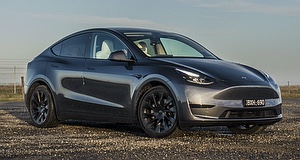
THIS is the car that should well and truly secure Tesla’s place in the automotive landscape – or at least, that’s what logic dictates.
As a mid-to-large SUV it’s got the form factor that the bulk of family buyers want, and, coupled with an EV powertrain that boasts a highly usable 455km single-charge range, its appeal should be obvious in an era where the cost of fuel is proving less stable than a vial of nitro-glycerine in a tumble-dryer.
But the Model Y is a latecomer to our market. It’s been more than two years between it going on sale in the US and its arrival on Australian roads, and in that time two Korean intruders have muscled in on the Model Y’s turf: Hyundai’s Ioniq 5 and Kia’s EV6.
Both are excellent – award-winning even – which puts the two-year-old Tesla on the back foot from the get-go. Recent price increases also mean it has null price advantage despite Tesla’s direct-sales model, with the Model Y currently selling for $72,300 before on-road costs, or circa-$84K drive-away in NSW, VIC and SA.
For context the Ioniq 5 Dynamiq RWD retails for $69,900 and Kia’s EV6 Air RWD is $72,590 pre-on-road costs.
So the price battleground is a level one – if not slightly tilted against the Tesla – so the Model Y needs to offer something the Ioniq 5 and EV6 can’t. Where’s the X-factor at? We borrowed the base Model Y rear-drive for a few days to find out.
Walking up to the Model Y, the initial impression is that it’s bigger than photos would have you believe. Its 2890mm wheelbase may be significantly shorter than the Ioniq 5’s three-metre stance, but an overall length of 4750mm means it puts the Koreans in the shade by more than a few centimetres.
If the three-row Model X is a large SUV then by rights the Model Y is a mid-sizer, but dimensions like that push it to the upper edge of that definition. It hides its bulk well though, visually speaking, thanks to Tesla’s amorphous-blob design language that, I’ll be honest, doesn’t really engage me as much as the spaceship styling of Hyundai’s pure EV SUV.
Inside, this is one of Tesla’s more convincing cabins – at least insofar as its utility. A conventional centre console sits at hip-height and contains deep storage bins, an armrest, two wireless charge pads (with a nice microsuede anti-slip backpanel) and a pair of cupholders.
The door pockets are generously sized, the boot is wide and deep with massive under-floor storage, and the rear seatbacks fold down at the press of a button.
The design is as sober and streamlined as the exterior, but it’s trimmed nicely with microsuede panels on the door cards and supple vegan leather on the seats – bright white in the case of this tester, but an all-black configuration is also available that’ll save you $1500 versus the white option.
Quality qualms? Tesla has attracted them in the past, but the fit and finish of this Chinese-built Model Y (all Aus-bound Model Ys are built in Tesla’s Chinese plant) was tight and issue-free.
There are still some Tesla-isms that make it harder to love this cabin, however. The company’s insistence that a single centre-mounted screen is sufficient for both infotainment and critical driver information like the speedometer is, to put it plainly, just wrong, especially in the absence of a head-up display.
There’s a good amount of screen real estate at least, and Tesla’s latest in-car software is one of the slickest in the business with near-instant response to finger prods and swipes, and almost no lag when swapping between different menu pages. If you can get your head around an iPhone, you’ll have an easy time getting to grips with this 15.0-inch touchscreen.
Another annoyance is the almost total absence of any control labelling. Did you know the transmission selector stalk is also the thing that activates cruise control? You’d never figure it out by simply looking at it. Same too with using the steering wheel scroll wheels to adjust the mirrors or having to adjust the direction of the air vents via the screen.
Simple features become needlessly complex when Tesla’s user interface engineers get involved.
But when it comes to comfort and space, the Model Y has both in abundance. The front seats offer enough adjustability and support to remain comfortable after hours behind the wheel, and the back seat is equally as roomy.
Rear seat legroom is generous, there’s enough headroom even for top hat enthusiasts to keep their headgear donned, and the angle of backrest and seat base also provides a comfortable posture, with an extra step of recline for the backrest for better road trip snoozability.
Rear air vents, heated outer seats and USB-C power outlets should keep your backseaters happy too, and if you’re concerned about whether everyone will be in for a case of severe sunburn thanks to that enormous glass sunroof (standard equipment, amazingly enough), it’s made with an optical coating that rejects UV and infrared heat and keeps the top of your dome cool.
And if you’re wondering how that correlates to the Tesla Model 3 which sits on the same platform, there are big advantages to the Model Y in terms of not just headroom, but back seat legroom – in the Model Y, those in the back have 135mm more distance between their knees and the front seats.
Boot space is also a win for the Model Y, with 854 litres when measured to the roof and including the under-floor area, compared to the Model 3’s 561 litres. Under the bonnet the Model Y boasts a 117-litre storage area, bigger than the Model 3 by 29 litres.
If you’re tossing up between the $65,500 Model 3 RWD and the Model Y RWD, the $7K price differential buys you cabin volume more than anything else.


